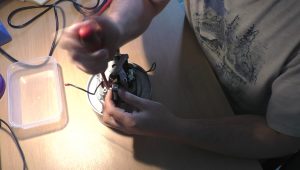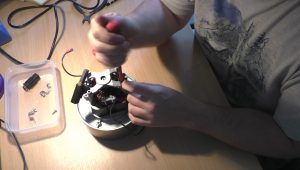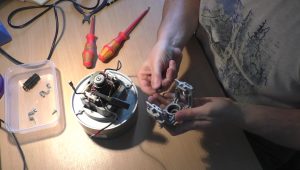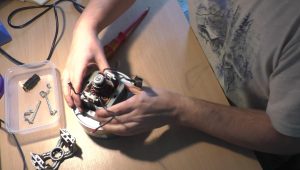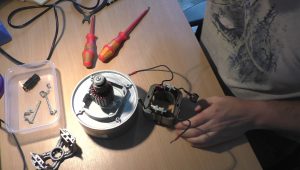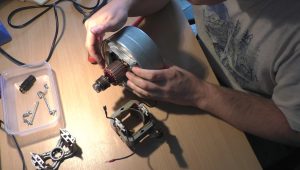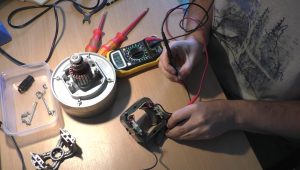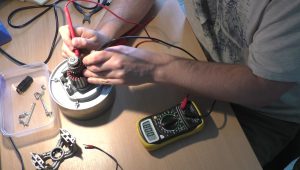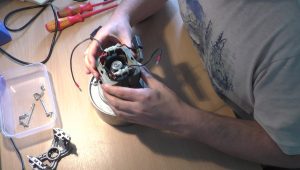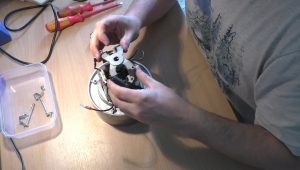A couple of months ago the motor in my Numatic Henry vacuum cleaner died. At the time I was using it as a workshop dust extractor and it was connected to my belt sander. It was working moderately hard but nothing I wouldn’t expect it to be able to cope with. I hadn’t long replaced the motor after the original one burnt out so I was more than a little disappointed to be replacing it again so soon. I wanted to find out why the motor had failed so I set about doing a full autopsy. In the end it turned out that all the motor needed was a new brush but just to be sure I fully stripped it down and tested each component.
Dismantling
This particular motor unit comes complete with the impeller assembly attached to the bottom of it.
Start by removing the brush clips. A regular Philips or Pozi screwdriver will work. With the clip off give the brush a wiggle while lifting it up. The carbon brush is spring loaded and quite brittle so take care not to let it fly out if you can. The brush is connected with a spade connector and in my unit it was exceedingly tight. I tried to carefully separate it with a flat bladed screwdriver without much luck. Since this brush was fine so I opted to leave it attached rather than risk damaging it taking it off.
The brush on the other side however was a different matter, the carbon electrode didn’t pop out when I pulled the brush housing free. For some reason the brush had become jammed in the housing and this caused the motor to fail.
Typically you’d want to stop here as you’ve clearly found a problem with the motor. If you want to go deep though and test the whole motor though you can now take the top housing off which will give you access to the rotor and stator. The stator just lifts off the rotor, no further disassembly is required for a full test.
Testing
Start by simply giving the motor a good visual inspection. If the insulation in the windings has failed you’ll likely see sooty burn marks somewhere on either the stator or the rotor. The most common location for a failure is just under the commutator (the divided copper area the brushes run on). This motor looks good.
If everything looks good get out your multimeter and start measuring the resistance of the windings. For a motor of this size the resistance should be a few omhs maximum and there should be no short to the core (the laminated steel the windings are wrapped around). In this case the stator windings measured 2.9 ohms and 3.0 ohms which is what I’d expect.
If the stator looks good move on to the rotor. Pick a commutator section and measure the resistance to each other section. This is fiddly to check but as with the stator the readings should be around an ohm rising to a few ohms for sectors opposite to the start sector. I had values ranging from 1 ohm to 2.5 ohms.
While testing I noticed that a cable tie had failed so I replaced it. The cable ties help stabilise the motor windings while in use which in turn prevents cracks in the insulation so taking the time to replace it is worth it.
Reassembly and Further Testing
Reassemble the motor by first carefully sliding the stator over the rotor and then attaching the top mounting. Take care to fit the sprung washing in the top if it fell out and not to damage the brush if you left it attached as I did.
As this is a universal motor you can power it from either AC or DC. If you want to be absolutely sure that it was just the brush that was the problem you can run the motor from a low voltage power source. In my case I used my bench power supply set to 12V and 1 Amp but I’d guess you could probably get it to spin with a fresh 9V battery. Don’t run the motor for more than a few seconds like this or you risk damaging the commutator.
That’s it, the motor has been thoroughly checked and the problem was just a failed brush. In reality you’d probably stop as soon as you noticed the brush had failed as there’s not much else you can fix but it’s a good learning experience to dig a little deeper.



